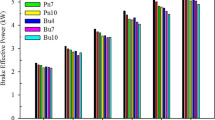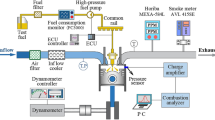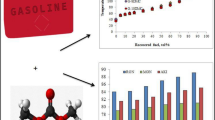Abstract
Diesel fuel and corn oil are mixed in the 80:20 volumetric ratio. Dimethyl carbonate and gasoline are added to diesel fuel + corn oil blend in 4:96, 6:94, 8:92, and 10:90 volumetric ratios to obtain ternary blends. Effects of ternary blends on the performance and combustion characteristics of a diesel engine are investigated under different engine speeds (1000–2500 rpm). 3D Lagrange interpolation method is applied to measured data of dimethyl carbonate blends to predict the engine speed, blending ratio, and crank angle giving maximum peak pressure and peak heat release rate. On average, dimethyl carbonate blends and gasoline blends show 4.3642–12.1578% and 1.0323–8.6843% reduction in effective power, and 1.4938–3.4322% and 4.3357–8.7188% reduction in effective efficiency, respectively, relative to diesel fuel. On average, there is a reduction in cylinder peak pressure (4.6701–7.3418%; 4.0457–6.2025%) and peak heat release rate (0.8020–4.5627%; 0.4–1.2654%) for dimethyl carbonate blends and gasoline blends, respectively, compared to diesel fuel. Because of low relative errors (1.0551% and 1.4553%), 3D Lagrange provides well accuracy in the prediction of maximum peak pressure and peak heat release rate. On average, dimethyl carbonate blends produce less CO (7.4744–17.5424%), HC (15.5410–29.5501%) and smoke (14.1767–25.2834%) emissions, compared with diesel fuel.








Similar content being viewed by others
Data availability
Not applicable.
Abbreviations
- ATDC:
-
After top-dead-center
- BEP:
-
Brake effective power (Ne, kW)
- BEE:
-
Brake effective efficiency (ηe)
- BSEC:
-
Brake specific energy consumption (MJ/kWh)
- BSFC:
-
Brake specific fuel consumption (be, kg fuel/kWh)
- BT:
-
Brake torque (T, Nm)
- BTE:
-
Brake thermal efficiency
- CO2 :
-
Carbon dioxide
- CO:
-
Carbon monoxide
- Cp :
-
Specific heat at constant pressure (J/kgK)
- CR:
-
Compression ratio
- Cv :
-
Specific heat at constant volume (J/kgK)
- dQn/dθ:
-
Net heat release rate per crank angle (J/degree)
- DF:
-
Diesel fuel used in this study
- DMC:
-
Dimethyl carbonate used in this study
- DMC4:
-
Ternary blend (76.8% DF + 19.2% corn oil + 4% DMC)
- DMC6:
-
Ternary blend (75.2% DF + 18.8% corn oil + 6% DMC)
- DMC8:
-
Ternary blend (73.6% DF + 18.4% corn oil + 8% DMC)
- DMC10:
-
Ternary blend (72% DF + 18% corn oil + 10% DMC)
- f(x):
-
A real-valued continuous function
- GL:
-
Unleaded gasoline used in this study
- GL4:
-
Ternary blend (76.8% DF + 19.2% corn oil + 4% GL)
- GL6:
-
Ternary blend (75.2% DF + 18.8% corn oil + 6% GL)
- GL8:
-
Ternary blend (73.6% DF + 18.4% corn oil + 8% GL)
- GL10:
-
Ternary blend (72% DF + 18% corn oil + 10% GL)
- HC:
-
Hydrocarbon
- HRR:
-
Heat release rate (J/degree)
- ID:
-
Ignition delay (crank angle degree)
- Li(x):
-
Weighting coefficient
- NHRR:
-
Neat heat release rate (J/degree)
- NOx :
-
Nitrogen oxides
- n:
-
Number of data points
- P:
-
Instantaneous in-cylinder gas pressure (Pa or bar)
- Pn − 1(x):
-
(n − 1)-th order polynomial
- Q(x, y, z):
-
A polynomial that interpolates f(x, y, z) in the given data
- R :
-
Calculated value (BEP, BSFC, and BEE)
- TDC:
-
Top-dead-center
- t = f(x, y, z):
-
A real-valued continuous the function
- V:
-
Instantaneous volume of the cylinder (m3)
- Xi(x):
-
Lagrange interpolation coefficient
- x1, x2, ..., xp :
-
Distinct points at x-coordinate
- Yj(y):
-
Lagrange interpolation coefficient
- y1, y2, ..., ym :
-
Distinct points at y-coordinate
- Zk(z):
-
Lagrange interpolation coefficient
- z1, z2, ..., zn :
-
Distinct points at z-coordinate
- θ:
-
Crank angle (degree)
- α1, α2, α3, ..., αn :
-
Independent variables
References
Abdalla AOG, Liu D (2018) Dimethyl carbonate as a promising oxygenated fuel for combustion: a review. Energies 11(6):1552. https://doi.org/10.3390/en11061552
Aguado-Deblas L, Hidalgo-Carrillo J, Bautista FM, Luna D, Luna C, Calero J, Posadillo A, Romero AA, Estevez R (2020) Diethyl ether as an oxygenated additive for fossil diesel/vegetable oil blends: evaluation of performance and emission quality of triple blends on a diesel engine. Energies 13(7):1542. https://doi.org/10.3390/en13071542
Aguado-Deblas L, Hidalgo-Carrillo J, Bautista FM, Luna C, Calero J, Posadillo A, Romero AA, Luna D, Estevez R (2021) Evaluation of dimethyl carbonate as alternative biofuel. Performance and smoke emissions of a diesel engine fueled with diesel/dimethyl carbonate/straight vegetable oil triple blends. Sustainability 13(4):1749. https://doi.org/10.3390/su13041749
Armstrong E, Hewson JC, Sutherland JC (2022) Characterizing tradeoffs in memory, accuracy, and speed for chemistry tabulation techniques. Combust Sci Technol:1–20. https://doi.org/10.1080/00102202.2022.2028780
Atmanli A, Ileri E, Yüksel B (2014) Experimental investigation of engine performance and exhaust emissions of a diesel engine fueled with diesel-n-butanol-vegetable oil blends. Energy Convers. Manag 81:312–321. https://doi.org/10.1016/j.enconman.2014.02.049
Auti SM, Rathod WS (2021) Effect of hybrid blends of raw tyre pyrolysis oil, karanja biodiesel and diesel fuel on single cylinder four stokes diesel engine. Energy Reports 7:2214–2220. https://doi.org/10.1016/j.egyr.2021.04.007
Bayraktar H (2008) An experimental study on the performance parameters of an experimental CI engine fueled with diesel-methanol-dodecanol blends. Fuel 87(2):158–164. https://doi.org/10.1016/j.fuel.2007.04.021
Bilgin A, Durgun O, Şahin Z (2002) The effects of diesel-ethanol blends on diesel engine performance. Energy Sources 24(5):431–440. https://doi.org/10.1080/00908310252889933
Bozorgmanesh AR, Otadi M, Kordi AAS, Zabihi F, Ahmadi MB (2009) Lagrange two-dimensional interpolation method for modeling nanoparticle formation during RESS process. Int. J. Ind. Math 1(2):175–181
Chapra SC (2012) Applied numerical methods with Matlab for engineers and scientists, third edn. McGraw-Hill, Natick, USA
Dabi M, Sahoo BB, Saha UK (2021) Increase of efficiency and reduction of CO and NOx emissions in a stationary compression ignition engine run on Mesua ferrea Linn oil-diesel and diethyl ether. Therm. Sci. Eng. Prog 25:100980. https://doi.org/10.1016/j.tsep.2021.100980
Edík JC, Pexa M, Holúbek M, AleÅi Z, Pražan R, Kuchar P (2020) Effect of diesel fuel-coconut oil-butanol blends on operational parameters of diesel engine. Energies 13(15):3796. https://doi.org/10.3390/en13153796
European Parliament (2003) Directive 2003/30/EC of the European Parliament and of the Council of 8 May 2003 on the promotion of the use of biofuels or other renewable fuels for transport. https://eur-lex.europa.eu/legal-content/EN/TXT/PDF/?uri=CELEX:32003L0030&from=en. Accessed 10 Sept 2022
European Parliament (2021) Regulation (EU) 2018/1999 of the European Parliament and of the Council and Directive 98/70/EC of the European Parliament and of the Council as regards the promotion of energy from renewable sources, and repealing Council Directive (EU) 2015/652. https://eur-lex.europa.eu/legal-content/EN/TXT/?uri=CELEX%3A52021PC0557. Accessed 11 Sept 2022
Faires JD, Burden RL (2012) Numerical methods, fourth edition. Boston, US. Brooks/Cole Cengage Learning
Fan C, Guan Z, Wei J, Pan M, Huang H, Wei M (2022) An assessment of soot chemical property from a modern diesel engine fueled with dimethyl carbonate-diesel blends. Fuel 309:122220. https://doi.org/10.1016/j.fuel.2021.122220
Fausett L (2002) Numerical methods using Mathcad. Prentice Hall, New Jersey 07458 USA
Fogiel M (1993) The numerical analysis problem solver. Research & Education Association 61 Ethel Road West Piscataway, New Jersey 08854 USA.
Ghadikolaei MA, Wong PK, Cheung CS, Ning Z, Yung KF, Zhao J, Gali NK, Berenjestanaki AV (2021) Impact of lower and higher alcohols on the physicochemical properties of particulate matter from diesel engines: a review. Renew. Sustain. Energy Rev 143:110970. https://doi.org/10.1016/j.rser.2021.110970
Gülüm M, Bilgin A (2019) Measurement and prediction of density and viscosity of different diesel-vegetable oil binary blends. Environ. Clim. Technol 23(1):214–228. https://doi.org/10.2478/rtuect-2019-0014
Heinold B (2019) An intuitive guide to numerical methods. https://www.brianheinold.net/numerical/numerical_book.html. Accessed 11 Dec 2022
Heywood JB (1988) Internal combustion engine fundamentals. McGraw Hill Series in mechanical engineering. isbn:0-07-100499-8
Hoang AT, Le VV, Pham VV, Tham BC (2019) An investigation of deposit formation in the injector, spray characteristics, and performance of a diesel engine fueled with preheated vegetable oil and diesel fuel. Energy Sources, Part A: Recovery, Utilization, and Environmental Effects. 41(23):2882–2894. https://doi.org/10.1080/15567036.2019.1582731
Holman JP (2001) Experimental methods for engineers, seventh edn. McGraw-Hill, New York
Huang ZH, Jiang DM, Zeng K, Liu B, Yang ZL (2003) Combustion characteristics and heat release analysis of a direct injection compression ignition engine fuelled with diesel-dimethyl carbonate blends. Proceedings of the Institution of Mechanical Engineers, Part D: Journal of Automobile Engineering. 217(7):595–605. https://doi.org/10.1243/095440703322114979
Isaacson E, Keller HB (1994) Analysis of numerical methods. Dover Publications, New York
Li M, Zhao Y, Fang J, Zhao S, Xu G, Wang Z (2020) Effect of dimethyl carbonate on the micromorphology and structure of combustion particles from diesel engines. Energy Sources, Part A: Recovery, Utilization, and Environmental Effects 42(9):1155–1165. https://doi.org/10.1080/15567036.2019.1602225
Nabi MN, Hussam WK, Afroz HMM, Rashid AB, Islam J, Mukut ANMM (2022) Investigation of engine performance, combustion, and emissions using waste tire Oil-Diesel-Glycine max biodiesel blends in a diesel engine. Case Stud. Therm. Eng 39:102435. https://doi.org/10.1016/j.csite.2022.102435
NationMaster (2022) Maize oil production in the world. https://www.nationmaster.com/nmx/ranking/maize-oil-production. Accessed 29 May 2022
Prakash T, Geo VE, Martin LJ, Nagalingam B (2018) Effect of ternary blends of bio-ethanol, diesel and castor oil on performance, emission and combustion in a CI engine. Renew. Energy 122:301–309. https://doi.org/10.1016/j.renene.2018.01.070
Pulkrabek WW (1997) Engineering fundamentals of the internal combustion engine, Second edn. Prentice Hall Upper Saddle River, New Jersey 07458 ISBN: 0135708540
Qi D, Ma L, Chen R, Jin X, Xie M (2021) Effects of EGR rate on the combustion and emission characteristics of diesel-palm oil-ethanol ternary blends used in a CRDI diesel engine with double injection strategy. Appl. Therm. Eng 199:117530. https://doi.org/10.1016/j.applthermaleng.2021.117530
Sanli H, Alptekin E, Canakci M (2022) Using low viscosity micro-emulsification fuels composed of waste frying oil-diesel fuel-higher bio-alcohols in a turbocharged-CRDI diesel engine. Fuel 308:121966. https://doi.org/10.1016/j.fuel.2021.121966
Sivanathan S, Chandran H (2014) Investigation on the performance and emission characteristics of biodiesel and its blends with oxygenated additives in a diesel engine. SAE Technical Papers 2014-01-1261. https://doi.org/10.4271/2014-01-1261.
TecQuipment (2022) Tecquipment regenerative engine test set. https://www.tecquipment.com/regenerative-engine-test-set. Accessed 15 Nov 2022
Torres-García M, García-Martín JF, Jiménez-Espadafor Aguilar FJ, Barbin DF, Álvarez-Mateos P (2020) Vegetable oils as renewable fuels for power plants based on low and medium speed diesel engines. J. Energy Inst 93(3):953–961. https://doi.org/10.1016/j.joei.2019.08.006
Tutak W, Jamrozik A (2018) Combustion of mixture of diesel fuel with gasoline in a compression ignition engine. Journal of KONES Powertrain and Transport 25(2):391–398. https://doi.org/10.5604/01.3001.0012.2861
Wang F, Wu J, Liu Z (2004) Surface tension of dimethyl carbonate (C3H6O3). Fluid Phase Equilibria 220(1):123–126. https://doi.org/10.1016/j.fluid.2004.03.002
Wang Q, Ni J, Huang R (2022) The potential of oxygenated fuels (n-octanol, methylal, and dimethyl carbonate) as an alternative fuel for compression ignition engines with different load conditions. Fuel 309:122129. https://doi.org/10.1016/j.fuel.2021.122129
Wei J, Fan C, Qiu L, Qian Y, Wang C, Teng Q, Pan M (2020) Impact of methanol alternative fuel on oxidation reactivity of soot emissions from a modern CI engine. Fuel 268:117352. https://doi.org/10.1016/j.fuel.2020.117352
Wei J, Lu W, Pan M, Liu Y, Cheng X, Wang C (2020) Physical properties of exhaust soot from dimethyl carbonate-diesel blends: characterizations and impact on soot oxidation behaviour. Fuel 279:118441. https://doi.org/10.1016/j.fuel.2020.118441
Wei J, Lu W, Zeng Y, Huang H, Pan M, Liu Y (2022) Physicochemical properties and oxidation reactivity of exhaust soot from a modern diesel engine: effect of oxyfuel type. Combust Flame 238:111940. https://doi.org/10.1016/j.combustflame.2021.111940
Wen LB, Xin CY, Yang SC (2010) The effect of adding dimethyl carbonate (DMC) and ethanol to unleaded gasoline on exhaust emission. Appl. Energy 87(1):115–121. https://doi.org/10.1016/j.apenergy.2009.06.005
Yang J, Jiang Y, Karavalakis G, Johnson KC, Kumar S, Cocker DR, Durbin TD (2016) Impacts of dimethyl carbonate blends on gaseous and particulate emissions from a heavy-duty diesel engine. Fuel 184:681–688. https://doi.org/10.1016/j.fuel.2016.07.053
Yaya L, Cong Y, Lianping S, Qiuyang C, Shitao Y, Lu L (2021) Rough-surface hydroxyl-group-rich hollow mesoporous silica nanospheres with nanocellulose as a template to improve the oxidation stability of bio-oil. Biomass and Bioenergy 154:106243. https://doi.org/10.1016/j.biombioe.2021.106243
Yesilyurt MK, Aydin M, Yilbasi Z, Arslan M (2020) Investigation on the structural effects of the addition of alcohols having various chain lengths into the vegetable oil-biodiesel-diesel fuel blends: an attempt for improving the performance, combustion, and exhaust emission characteristics of a compression ignition engine. Fuel 269:117455. https://doi.org/10.1016/j.fuel.2020.117455
Zhang GD, Liu H, Xia XX, Zhang WG, Fang JH (2005) Effects of dimethyl carbonate fuel additive on diesel engine performances. Proceedings of the Institution of Mechanical Engineers, Part D: Journal of Automobile Engineering 219(7):897-903. https://doi.org/10.1243/095440705X28358
Zhang Y, Zhong Y, Lu S, Zhang Z, Tan D (2022) A comprehensive review of the properties, performance, combustion, and emissions of the diesel engine fueled with different generations of biodiesel. Processes 10(6):1–55. https://doi.org/10.3390/pr10061178
Author information
Authors and Affiliations
Contributions
Mert Gülüm: conceptualization, methodology, formal analysis, measurements, analysis, investigation, resources, visualization, writing — original draft.
Corresponding author
Ethics declarations
Ethics approval
Not applicable.
Consent to participate
Not applicable.
Consent for publication
Not applicable.
Competing interests
Not applicable.
Additional information
Responsible Editor: Philippe Garrigues
Publisher’s note
Springer Nature remains neutral with regard to jurisdictional claims in published maps and institutional affiliations.
Supplementary information
Supplementary file 1
Appendix Figures (DOCX 1.91 MB)
Supplementary file 2
Appendix Tables (DOCX 31.2 KB)
Rights and permissions
Springer Nature or its licensor (e.g. a society or other partner) holds exclusive rights to this article under a publishing agreement with the author(s) or other rightsholder(s); author self-archiving of the accepted manuscript version of this article is solely governed by the terms of such publishing agreement and applicable law.
About this article
Cite this article
Gülüm, M. Effect of adding dimethyl carbonate and gasoline to diesel fuel + corn oil blend on performance and combustion characteristics of a diesel engine. Environ Sci Pollut Res (2023). https://doi.org/10.1007/s11356-023-27121-y
Received:
Accepted:
Published:
DOI: https://doi.org/10.1007/s11356-023-27121-y




